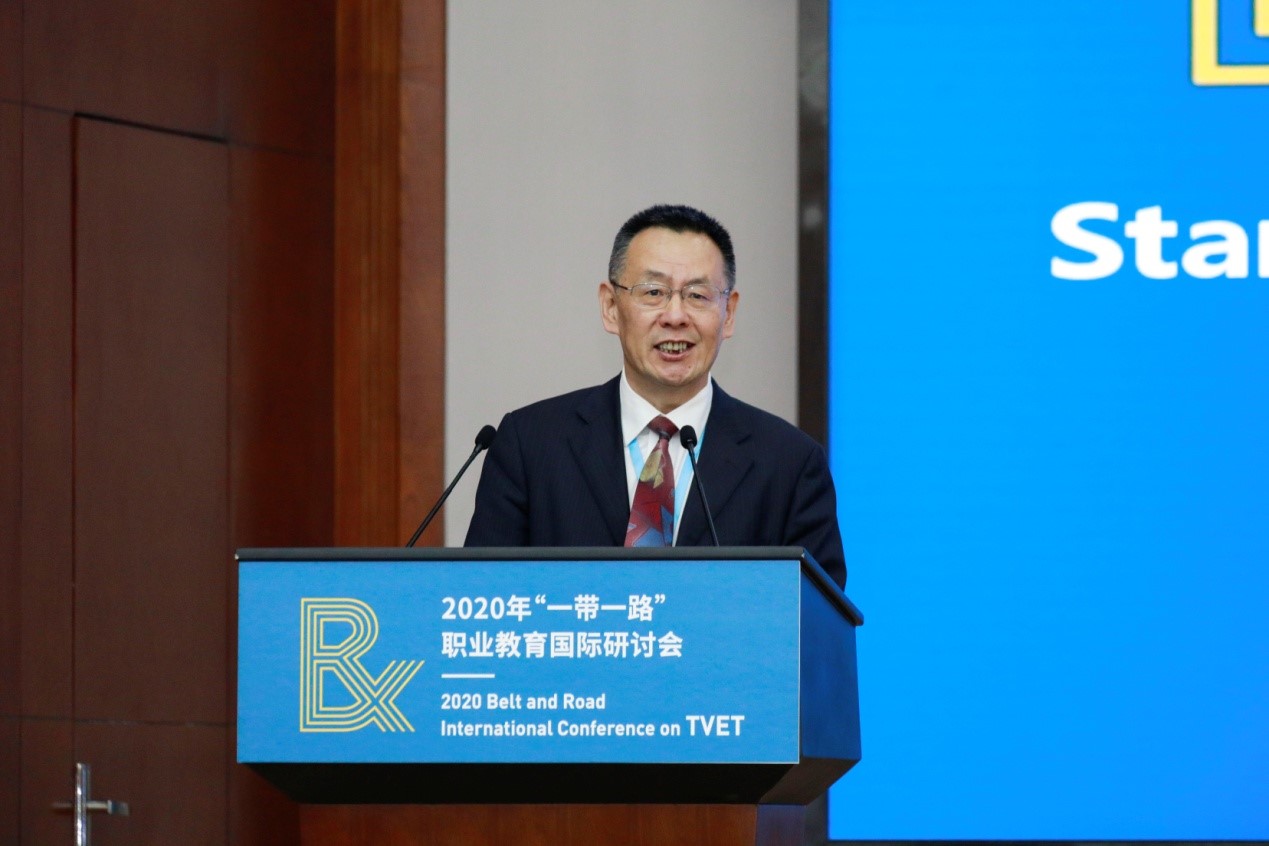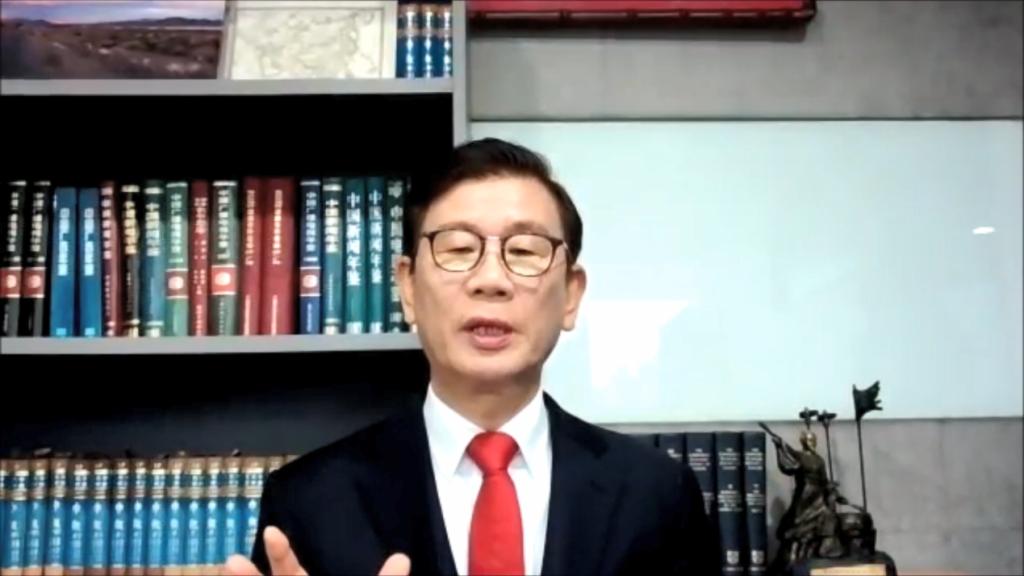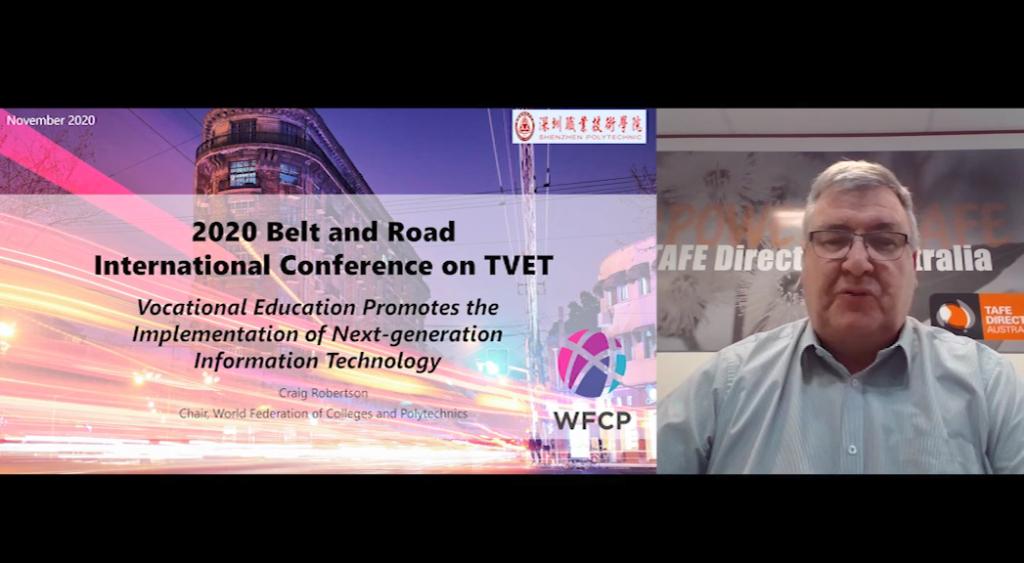On November 26-27, 2020 Belt and Road International Conference on TVET with the theme of "Construction of Digital Vocational Education, Consultation and Cooperation for Shared Benefits" was held in Shenzhen. Centering on the facilitation of global supply chain through digital vocational education, advancement of the landing of new-generation information technology application, vocational education in 5G application subdivision and exploration and practice of the digital transformation of vocational education, over 300 domestic and foreign officials, experts and scholars made an in-depth dialogue. With open minds and sparkling views, they jointly planned a grand blueprint for digital vocational education. This article selects the on-site quotes of 17 guests in three dialogue sections for readers to enjoy.
Keynote Speech
Liu Jiantong, Standing Vice-chairman and Secretary General of the Chinese Society for Technical and Vocational Education

To further deepen the structural reform and forge new growth drivers in the post-pandemic era through scientific and technological innovation and digital transformation after the outbreak of the pandemic, it is one of our vital measures to develop education, especially vocational education. As vocational education shoulders the important task of supplying high-quality personnel for the era of digital economy, China initiated its professional upgrading and digital transformation of vocational education in the latter half of this year. With the adjustment and revision of the professional directory as a carrier, it aims to further generate changes in such aspects as professional names, connotation, curriculum system and staple courses of vocational education, consolidate some achievements made in the reformation and innovation and improve the suitability of vocational education to make new-generation information technology the true engine to lead in the innovative development of vocational education and vocational education the major supporting force to drive vigorous economic and social development in the new development pattern of the post-pandemic era.
YANG Phil Seung, Chairman of CKT group; 2017 Candidate for the People's Party Presidential Primaries for the Republic of Korea Presidential Election; International President of Jilin Vocational & Institute of Technology; Adjunct Professor of Tsinghua University; CEO of Mega AI Lab; Ph.D. in Chinese History from University of California, Los Angeles

We need to provide vocational education to the people with technological education in particular, which is very important for current young people. The current development of artificial intelligence technology inspires the whole industry of vocational education to think about how to cultivate artificial intelligence through vocational education. The broader artificial intelligence is deployed, the higher requirement is made of AI engineers. Meanwhile, we expect to effectively combine artificial intelligence teaching with vocational education. I believe the learning process will be more of follow-up enhancement and technological application than simple learning.
Craig Robertson, Chair of World Federation of Colleges and Polytechnics

Globally speaking, vocational education has entered the section of the implementation of innovation, and that is why more high-skill talents are produced and where the advantage of vocational education lies. Regarding human resources, they should be continuously in line with the development of the world and make repeated education and training at any time so as to match the development of society endlessly. At the same time, when everyone is able to receive vocational education to a certain degree, it will help us echo the development of the world in the processes of startup and working. To be even more important, we should make new investment in education for education cannot only help us recover after the COVID-19 but also help us improve digitalization and automatization including technological evolution, through which we hope everyone can be benefited.
Cutting-edge Dialogue
Carrie Yau, Executive Director of Vocational Training Council, Hong Kong

Digitization enables us to move beyond traditional geographical boundaries and enable students to truly have an international vision and cross-cultural communication skills. So we have built a very strong network that offers students exchange programs such as study, travel, industry visits and industry practices. We also continue to expand our organization throughout Greater Bay Area in the hope of better supporting our national development blueprint. We all know that technological innovation has become one of the most important agendas in the world. This is also a strategic key point in the 14thFive-Year Plan for China. We will continue to work hard to achieve the digitization of vocational education. At the same time, we will continue to expand the cooperation network along the "Belt and Road Initiative" and work with colleagues from all walks of life in Greater Bay Area to strengthen the talent cultivation in Hong Kong and the mainland.
Larry Rosia, President and CEO of the Saskatchewan Polytechnic (Canada)

I believe that the impact of the new crown epidemic will definitely be resolved, as long as we can maintain sufficient responsiveness, sufficient flexibility, and sufficient adaptability. Regardless of the impact of COVID-19, we must remember that we still have to have confidence in such a deep global impact. In this process, the digital virtualization will not be reversed. On the contrary, the COVID-19 trend will also accelerate the digital transformation, so we need to adopt more methods to allow these technologies to benefit more people. To do this, we need to cooperate. Only through cooperation can we find better ways to deal with it.
Gulnar Shaimergenova, Director of China Studies Center (Kazakhstan)

Information technology is actually an important starting point and pushing force for change. We know that China today is the leader in information technology in the world. Therefore, discussing education is a particularly important topic. In this process, it will involve how to promote cooperation within the framework of the "Belt and Road Initiative". Therefore, this is a valuable opportunity for bilateral cooperation between Kazakhstan and China. Kazakhstan has been actively promoting the development of information technology. Digitization is a very important way, which can help to achieve a new breakthrough in economic development and reach a higher platform.
LI Dingxin, Head of Research Department of China Center for Contemporary World Studies, International Department of the Central Government

Vocational education should directly serve the promotion of high-quality co-construction of the "Belt and Road Initiative", which fits well with the theme of "Belt and Road Initiative" vocational education development. "Belt and Road Initiative" is the overall starting point for foreign development. In the course of investigation and investigation, we found that the biggest factor restricting the development of "Belt and Road Initiative" is the human factor, that is to say, we still lack high-level vocational and technical personnel. This is not only in China, but also in more than 100 countries or partner countries under the construction of the "Belt and Road Initiative". Therefore, vocational education should be viewed from a higher perspective.
DU Kewei, Director-General of China Center for International People-to-People Exchange, Ministry of Education

Through people-to-people exchanges, mutual understanding and communication with the people will be enhanced and openness to the outside world will be expanded. Therefore, we say that people-to-people exchanges and opening to the outside world are mutually reinforcing relations. It is necessary to give full play to the educational function of humanities exchange, expand students' international vision and strengthen the international exchange of vocational education. Our center has also initiated and implemented a series of projects to promote cultural exchange between China and foreign countries through the integration of production and education. These projects can move the most advanced technology and equipment in the industry to the school's laboratory and training base, invite the best engineers from the enterprise to the school pulpit, and construct a training model of "technical skills+humanistic quality".
LU Shouji, Secretary-general of Silk-Road Industry and Finance International Alliance

We should put the docking position in place. There are at least three aspects in positioning: the first is the pattern positioning of vocational education in the national education system. The second is the mission orientation of schools in the education system. The third is the school's role in the application of the new generation of information technology. To sum up, your pattern positioning, your mission positioning and your angle positioning, that is, who I am, what I do, and what I should start from. This is the basis and conditions for promoting the application of the new generation of information technology in the next step.
HU Jiangyuan, Deputy General Manager of Higher Education Unit of iFLYTEK

In fact, artificial intelligence has become a new engine for the development of intelligence education. It collects these data through perception layer, camera or information system, and then creates a digital twin of people and things in the information space to empower users. Why do we use this to empower users? As a matter of fact, any manufacturer of information construction can't meet the individual demands of every role and school. After collecting these data, we can learn his thinking and experience through artificial intelligence, and then build our management system and teaching system. We can develop a new thinking suitable for a school, a class or even students to empower users based on this framework after the establishment.
University-enterprise Dialogue
Koon-shum CHOI, Deputy Director of the committee for Education, Science, Culture, Health and Sports, CPPCC, PRC, Chairman of the Chinese General Chamber of Commerce, Hong Kong and Chairman of Sunwah Group

At the request of the situation and partners, more and more vocational education in China, taking cross-border integration as the breakthrough point, integrates the Internet, cloud computing, big data and artificial intelligence into cross-teaching of different disciplines and professional groups, and pays attention to cultivating students' financial and business literacy, innovation and entrepreneurship awareness and cross-cultural communication ability outside of learning basic skills or a single discipline. At the same time, we will actively build a diversified platform, and constantly try to connect the education chain and talent chain with the industrial chain and innovation chain to build a comprehensive talent base. In addition, relying on the industrial research integration platform, China has jointly developed vocational education standards with Chinese characteristics and success genes with various countries and issued vocational skills certificates recognized by both parties. A "Belt and Road Initiative" vocational education community with mutual benefit and respect for different cultures, religions and national conditions has taken shape.
Morten Emborg, CEO and President of Technical Education Copenhagen (Denmark)

We still adopt the dual-track system when enrolling students, which can benefit students better for life. At the same time, students can also bring us new tools, new application scenarios and new technologies, including the need for further improvement of digital ability. At present, we are building digital courses in colleges, and at the same time building a digital ecosystem in Europe. Most of the teaching resources can be obtained online, including the realization of virtual reality technology and scenes. Especially during the COVID-19 epidemic, we are constantly improving digital teaching. It should be noted that students also play an important role in the innovation process.
Koh King Kee, Dean of ASEAN Branch of the National Academy of Belt and Road Green Development at China International Culture Exchange Center

One of the biggest constraints of online vocational education learning is the level of digital skills among teachers and trainers. In addition, digital vocational education will also be affected by the popularity of the Internet. At present, the penetration rate of the Internet in the world is 63.2%, with the highest penetration rate in North America and Europe reaching 90.3% or 87.2%, while the lowest penetration rate in Africa is only 47.1%. Other constraints exist, including students' difficulty in paying attention, especially in the virtual lecture process. Because there is no way to interact with teachers face to face, it is easy to be distracted and boring. Besides, online teaching requires teachers to have enough knowledge and digital skills, which is not easy for teachers in underdeveloped areas.
YANG Xinbin, Chairman of Board and President of Shenzhen Polytechnic

The main way of thinking in the article is to facilitate new technologies and related knowledge represented by AI, big data and block chain to penetrate into majors, courses, textbooks and classrooms by focusing on major groups and emphasizing on digital transformation, as well as to establish a docking dialogue mechanism for vocational education and digital economy. In line with the ten major transformation measures, we will build a number of international and domestic leading majors, cultivate a number of professional leaders and leaders with international influence, cultivate a number of professional construction achievements with international influence, and form a set of international leading vocational education mode with Chinese characteristics. Through the comprehensive transformation of the professional education ecology, a new talent training system under the background of the digital economy will be created.
HE Xingyue, President of Zhejiang Institute of Mechanical Electrical Engineering

Digital empowerment requires every vocational college to restructure its own ecosystem, which is actually a challenge for schools. Educational process reengineering needs to be manifested through digital technology. Digital technology requires to promote the reform of teaching model. Talent training and classroom teaching model must apply digital technology to achieve revolutionary changes, instead of tinkering with minor problems and patching up changes. Constructing digital organizational structure to effectively improve the internal governance ability of schools. Digitization enables the school to comprehensively improve its ability to serve the society and enterprises, cultivate a large number of famous teachers with status and influence in the industry, and enable the society to have more and higher recognition of vocational colleges through service enterprises.
ZHANG Hui, Senior Vice General Manager of Sany Heavy Industry Co., Ltd. And President of Sany University and Hunan Sany Polytechnic College

What might be the relationship between university presidents and employees in the future? One thing the headmaster may do is to build the platform so that more and more resources can flow on the platform. The other is that he has to release a task: I want to do something, I will launch it on the platform, the staff will form a team according to their needs, several people want to do this and form a team to do it. So it’s not about who gets the job, it’s about having an optimal or suboptimal team pick it up in the moment. For example, I want to teach a course on Tao Te Ching. No one in the school can teach it, but we have a cloud platform with a large number of external teachers. I sent this course to the platform, crowdsourced this course, which cost RMB 10,000, and many people may do it.
ZHU Linrui, Director of Unmanned Aerial Systems Training Center of DJI

There are three kinds of talents for DJI: manufacturing-the people who make airplanes, industry applications and SDK-people who use airplanes, R&D innovation-the people who design airplanes. In terms of number of people and employment demand, our focus will be on industry applications and SDK, because the number of people using airplanes is definitely the largest. For industry application UAV driving and SDK development engineers, the target is higher vocational education. We also advocate the use of "1+X" to empower various industries. It has two meanings. One is UAV is "1" and various industries are "X". Through the fixed platform of drones, all walks of life are empowered; The other is a 1+X certificate. In the future, we will provide colleges and universities with personnel training, laboratory construction, teacher training and competition programs based on our understanding of industry applications.
 School Motto:
School Motto:
 Search
Search
 School Motto:
School Motto:
 Search
Search